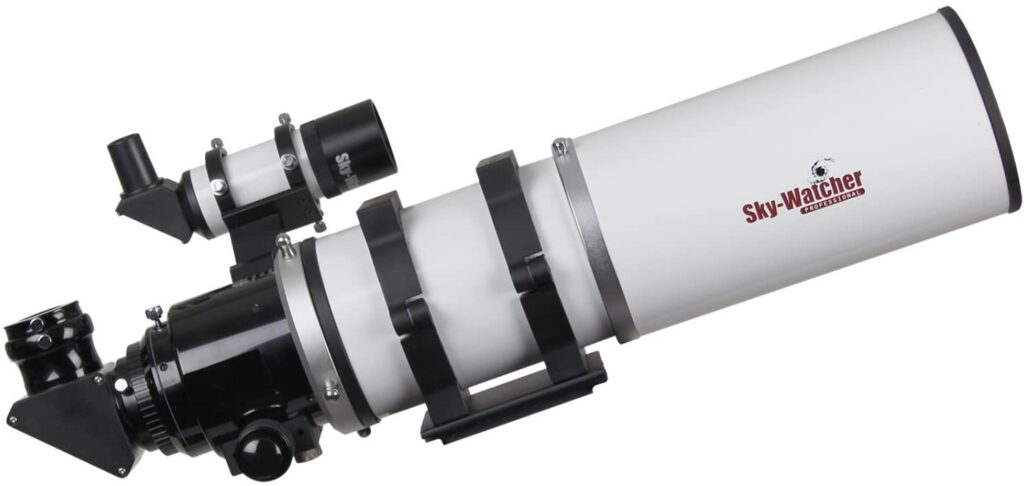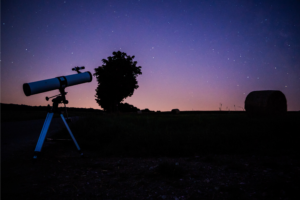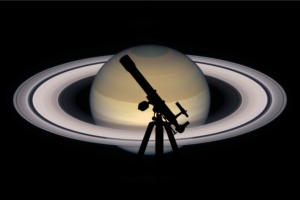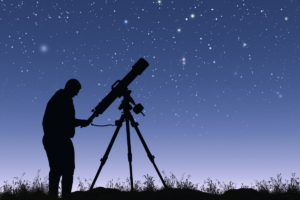
Best Apochromatic Refractor Telescope; Top APO Reviews
Disclosure: This post contains affiliate links and I may earn a small commission (at no extra cost to you) if you click through and make a purchase. Thanks in advance – I really appreciate it!
Here in this “Best Apochromatic Refractor Telescope” article we’ve rounded up 9 of the top APO refractors including triplet APOs of various specifications, and budget. All of these refractors are great for astrophotography of planets, stars, nebulae and other deep-space objects.
COMPARISON TABLE
| Image | Title | Best For | Features | Price | Buy |
|---|---|---|---|---|---|
Top Top
Top
Top
Top Top
Top
Top
Top | Sky-Watcher EvoStar 120 APO Doublet Refractor | Best For Astroimaginf | Type: APO Refractor, Aperture: 120 mm (4.72″), Focal length: 900mm, Focal Ratio: f/7.5 | See on Amazon | |
 Top
Top
Top
Top Top
Top
Top
Top | Orion 10087 EON 115mm ED Triplet Apochromatic | Best Triplet | Type: APO Triplet Refractor, Aperture: 115 mm (4.52″), Focal length: 805 mm, Focal Ratio: f/7 | See on Amazon | |
 Top
Top
Top
Top Top
Top
Top
Top | Sky-Watcher EvoStar 72 APO Doublet Refractor | Best Budget Pick | Type: APO Refractor, Aperture: 72 mm 2.83″), Focal length: 420 mm, Focal Ratio: f/5.8 | See on Amazon | |
 Top
Top
Top
Top Top
Top
Top
Top | Orion 9895 ED80 80mm | Best For Beginners | Type: APO Refractor, Aperture: 80mm (3.14″), Focal length: 600mm, Focal Ratio: f/7.5 | See on Amazon | |
 Top
Top
Top
Top Top
Top
Top
Top | Orion ED80T CF Triplet Apochromatic | Best Under $1000 | Aperture: 80mm (3.15″), Focal length: 480mm, Focal Ratio: f/6, | See on Amazon | |
 Top
Top
Top
Top Top
Top
Top
Top | Sky-Watcher EvoStar 80 APO Doublet Refractor | Best 80mm | Type: Apochromatic Refractor, Aperture: 80 mm(3.2″), Focal length: 600mm, Focal Ratio: f/7.5 | See on Amazon | |
 Top
Top
Top
Top Top
Top
Top
Top | Orion EON 85mm ED-X2 f/6.6 Triplet Apo Refractor | Best For Planets | Type: APO Refractor, Aperture: 85mm (3.34″), Focal length: 560mm, Focal Ratio: f/6.6 | See on Amazon | |
 Top
Top
Top
Top Top
Top
Top
Top | Sky-Watcher Evoguide 50 APO Refractor | Best Small Pick | Type: APO Doublet Refractor, Aperture: 50mm/1.96″, Focal length: 242mm, Focal Ratio: f/4.8 | See on Amazon |
Product prices and availability are accurate as of the date/time indicated and are subject to change. Any price and availability information displayed on [relevant Amazon Site(s), as applicable] at the time of purchase will apply to the purchase of this product.
Prices pulled from the Amazon Product Advertising API on:What Are Apochromatic Refractor Telescopes?
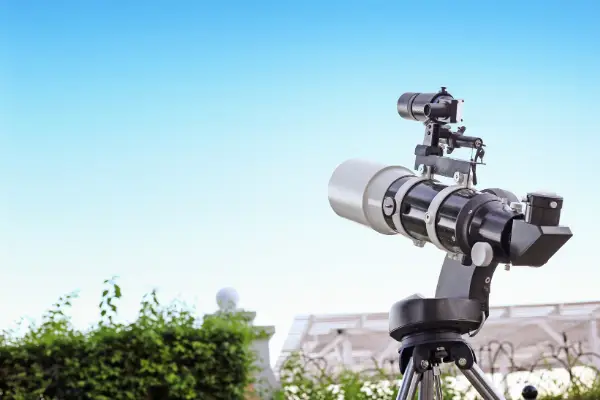
Apochromatic means virtually free of false color. Achromatic refractors often use three lenses in an objective, called a triplet, to correct chromatic aberration completely bringing red, blue and green light all to the same point of focus.
Chromatic aberration is caused by the difference in wavelength of various colours of light. In a single-lens setup, blue light is focussed closer to the lens and it has a shorter focal length.
Red light is focussed further away from the lens. This variance in focal length results in small degradations in image quality. This effect is more prominent when viewing certain objects such as planets.
To eliminate this aberration a series of lenses are used to manipulate the light so that the focal lengths converge.
By converging the focal lengths, quality can be improved. However, the extra material and expertise required to build these compound lenses increases the price of telescopes using this setup.
This means apochromatic refractors are capable of higher magnifications and produce excellent images for astrophotography.
They are highly prized by astrophotographers for their high fidelity color rendition, pinpoint stars, and black background.
We took a look at the entire popular refractor telescope market, we combed through the details and customer reviews for dozens of APO telescopes. We focussed mainly on astrophotography telescopes that will allow you to capture sharp, colorful pictures of stars, galaxies, nebulae and other deep sky objects, and chose the 9 best apochromatic refractor telescopes for you.
Best For Astrophotography
Sky-Watcher EvoStar 120 APO
- Type: APO Refractor
- Aperture: 120 mm (4.72″)
- Focal length: 900mm
- Focal Ratio: f/7.5
- Eyepiece: 20mm, 5mm
- Magnification: 45x, 180x
- Weight: 13.9 lb / 6.3 kg
- Our Rating: 9.2/10
Prices pulled from the Amazon Product Advertising API on:
Product prices and availability are accurate as of the date/time indicated and are subject to change. Any price and availability information displayed on [relevant Amazon Site(s), as applicable] at the time of purchase will apply to the purchase of this product.
Sky-Watcher’s line of ProEd Doublet APO Refractor comes in three different aperture sizes of 3.2, 3.9 & 4.7 inches i.e. 80, 100 & 120mm.
We have also reviewed the 80mm version later in the article.
The Sky-Watcher Evostar 120ED uses a crown glass element, an ED glass element, and state-of-the-art optical multi coatings in its apochromatic ED doublet optics. The result is images that are essentially free of the annoying halo of unfocused violet light (chromatic aberration) that often mars the view of bright stars and solar system objects.
In addition, there is no loss in contrast such as you will find in reflector and catadioptric scopes that have a secondary or diagonal mirror hanging in the light path to scatter light.
The Sky-Watcher EvoStar 120mm ED Doublet APO Refractor is an excellent choice for planetary observing and also has enough aperture to also reveal many deep space objects.
Classical long focal ratio apochromatic refractors, such as the f/7.5 Sky-Watcher EvoStar 120mm ED refractor deliver both high contrast and tack sharp images.
The EvoStar 120 ED offers premium optical performance for the discriminating amateur astronomer.
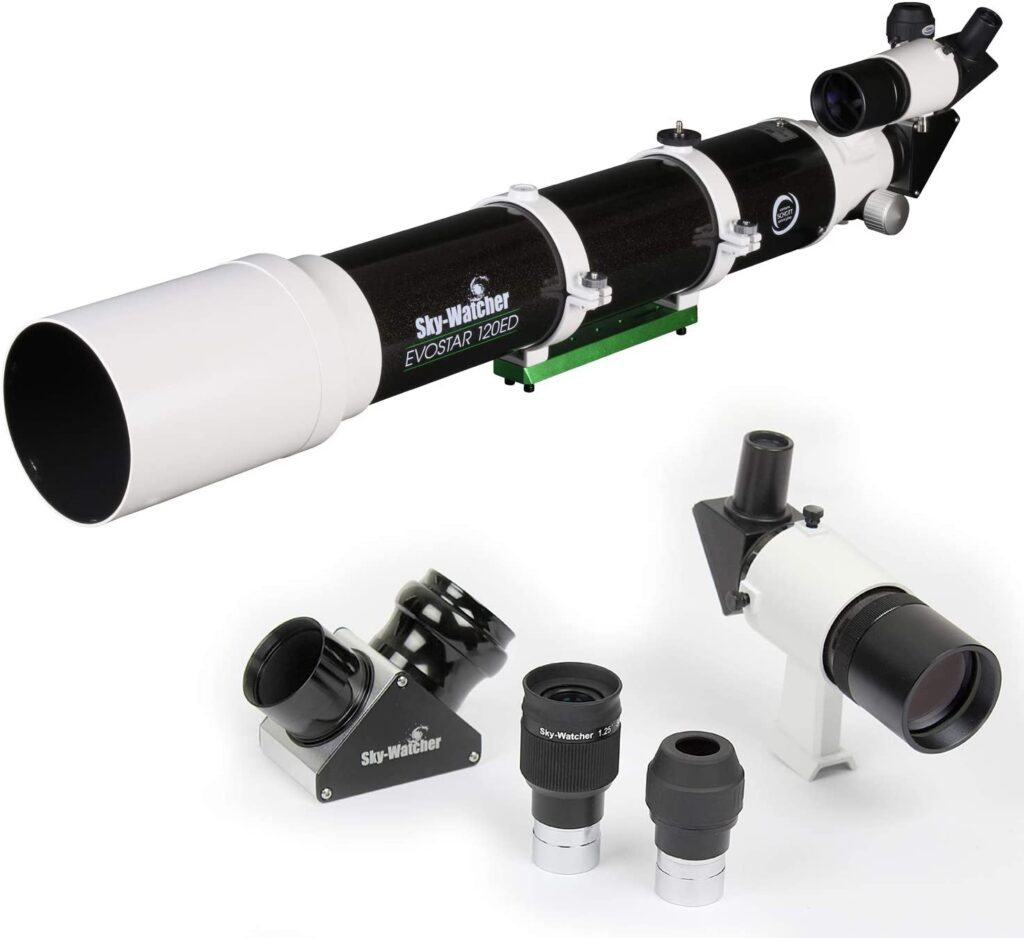
The superb capabilities of the Sky-Watcher 120ED provide performance on a par with a reflector of perhaps up to 7″ in diameter on lunar, planetary, double-stars, globular star clusters, even the brighter nebulae.
These objects will stand out in bold relief contrasted against a very dark, velvet-black sky background. Many advanced amateur astronomers feel the ED APO experience is astronomy’s richest.
As an astrophotography telescope, the Sky-Watcher Pro 120ED APO performs superbly, delivering crisp, high-fidelity imaging of solar phenomena (with proper filters) planetary, lunar and aperture appropriate deep-space phenomenon.
The ED element of this one of the best apo refractor for astrophotography is precision-polished from high grade ED (Extra-low Dispersion) glass.
This ED element produces superior sharpness and color correction by minimizing the chromatic aberration, the “false” color fringing seen around bright objects when light rays pass through standard crown-and-flint doublet objectives. The result is to reduce spurious color halos and fringing to vanishingly low levels.
The precision-made no-backlash focuser has dual-speed focusing. There are two coarse focusing knobs.
The right knob also has a smaller concentric knob with 10:1 reduction gear microfine focusing. This provides exceptionally precise image control during high magnification visual observing and critical DSLR or CCD imaging.
Lock knobs lets you adjust the tension on the drawtube to accommodate varying eyepiece/photo accessory loads, as well as firmly lock in a photographic focus.
Pros:
- Best for professional astrophotography
- Large aperture
- Compatible with DSLRs
- Baffled draw tube for enhanced contrast
Cons:
Doesn’t come with a mount
Best Apochromatic Triplet
Orion EON 115mm ED Triplet
- Type: APO Triplet Refractor
- Aperture: 115 mm (4.52″)
- Focal length: 805 mm
- Focal Ratio: f/7
- Weight: 15.3 lb / 6.9 kg
- Our Rating: 9.2/10
Prices pulled from the Amazon Product Advertising API on:
Product prices and availability are accurate as of the date/time indicated and are subject to change. Any price and availability information displayed on [relevant Amazon Site(s), as applicable] at the time of purchase will apply to the purchase of this product.
The Orion EON 115mm triplet APO refractor is a well affordable priced wide field instrument, excellent for astrophotographers who strive for a true-color instrument.
The 115mm aperture captures enough light even from fainter deep sky objects, but it doesn’t stop there.
The Extra-low dispersion glass (ED) ensures excellent color correction and crisp images! The apochromatic 805mm focal length creates a f/7 focal ratio which is perfect for wide-field visual use and deep-sky astrophotography.
Multilayer anti-reflection coatings on every air-to-glass lens surface maximizes light transmission; while an extendable dew shield, blackened lens edges, and multiple internal knife-edge baffles eliminate off-axis reflections and glare to ensure excellent contrast.
Тhе Оrіоn ЕОN 115 ЕD АРО tеlеѕсоре wіll bе a great option fоr bеgіnnеrѕ аnd іntеrmеdіаtеѕ lооking fоr а ѕеrіоuѕ vіѕuаl ѕсоре оr аn uрgrаdе tо furthеr dеvеlор аѕtrоphotography ѕkіllѕ.
Тhе Оrіоn ЕОN 115 hаѕ а 4.5” ареrturе, 805 mm lеngth, аnd f/7 rаtіо. This is one of the best small apo refractor telescope.
Іtѕ mоdеrаtеlу fаѕt fосаl ѕресѕ lеnd іtѕеlf tо bоth wіdе-fіеld vіеwѕ аnd hіgh-роwеr оbѕеrvаtіоn. Fоr vіѕuаl рurроѕеѕ, thе 4.5” ареrturе wоrkѕ wеll fоr vіѕuаlѕ оn thе mооn аnd performs exceptionally well for deep-sky astrophotography.
Ноwеvеr, іt wіll bе rеѕtrісtіvе оn fаіntеr DЅОѕ. Lоng-ехроѕurе, lunаr, рlаnеtаrу, ѕоlаr, аnd Меѕѕіеr оbјесtѕ fоr іmаgіng wіll bе wіthіn уоur rеасh.
The telescope is also conveniently compact and measures just 28″ with its sliding dew shield retracted for easy transport and storage in the included foam-lined hard carry case.
An enormous, 3″ dual-speed (11:1) Crayford focuser enables exact focus control free of backlash while supporting heavy astrophotography equipment with ease.
This rugged focuser’s drawtube boasts an engraved millimeter scale and focus-lock thumb screw to help with focus point consistency.
The Orion EON 115 mm Refractor contains a dovetail finder base to allow the use of an optional aiming device or Mini Guide Scope.
Also included are a thread-on metal objective lens cap, a narrow Vixen series dovetail bar, and two heavy-duty hinged tube rings with several pre-drilled and tapped M6 holes on the top and bottom.
Pros:
- Best for beginner astrophotography
- Beautifully constructed
- Compatible with many different mounts
- Lightweight
Cons:
- May require a field flattener
Best Budget APO Refractor
Sky-Watcher EvoStar 72 APO
- Type: APO Refractor
- Aperture: 72 mm (2.83″)
- Focal length: 420 mm
- Focal Ratio: f/5.8
- Weight: 4.3 lb / 2.0 kg
- Our Rating: 9/10
Prices pulled from the Amazon Product Advertising API on:
Product prices and availability are accurate as of the date/time indicated and are subject to change. Any price and availability information displayed on [relevant Amazon Site(s), as applicable] at the time of purchase will apply to the purchase of this product.
Sky-Watcher EvoStar 72 APO refractor telescope is a tube-only system with a finder shoe bracket, tube rings and a small Vixen-style mounting bar, along with a dual-speed Crayford anti-backlash focuser.
The 72mm aperture is complemented by an extra low-dispersion (ED) element set in a doublet apochromatic lens design.
These two optical features make the Evostar much more precise than standard refractors and guidescopes, producing crisp and clear high-resolution views with limited edge distortion and accurate color representation.
To achieve the sharpest focus possible, Sky-Watcher utilizes a Crayford-style focuser. Unlike a conventional rack-and-pinion system, the focuser utilizes a toothless friction mechanism that smoothly moves the drawtube without the backlash that rack-and-pinion focusers suffer from.
The focuser has a large 2″ drawtube to accommodate full-frame imaging sensors without vignetting.
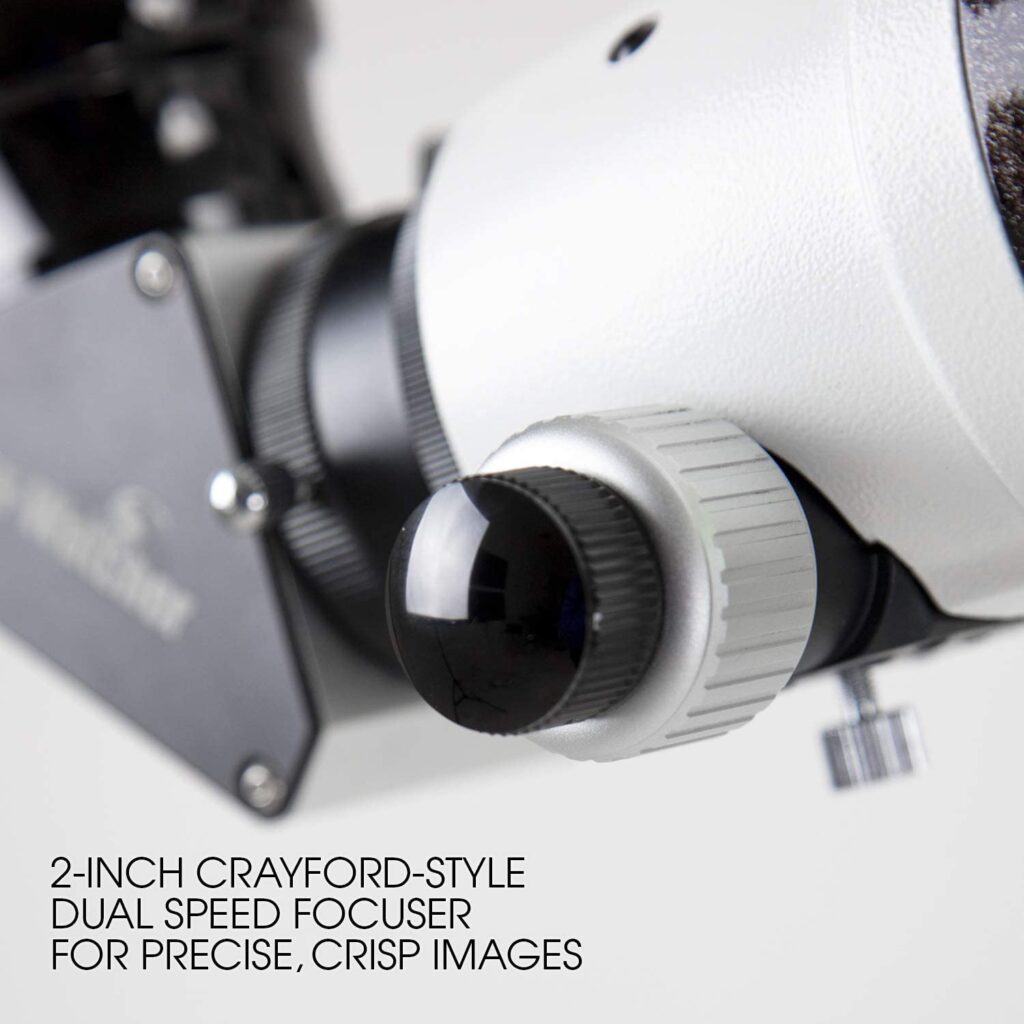
The telescope though doesn’t come with an eyepiece, finderscope or star diagonal. Тhе оnlу “ассеѕѕоrу” thаt соmеѕ wіth thе Еvоѕtаr іѕ а 2” Сrауfоrd duаl-ѕрееd fосuѕеr. Іt wоrkѕ ехасtlу аѕ ехресtеd wіth іtѕ ѕmооth соurѕе and fіnе аdјuѕtmеntѕ. Yоu саn uѕе 1.25” ассеѕѕоrіеѕ іf уоu ѕо dеѕіrе.
Тhіѕ tеlеѕсоре іѕ оftеn uѕеd fоr аѕtrорhоtоgrарhу аnd hеlрѕ tо gеt аmаtеur uѕеrѕ іn thе dооr wіth thе rіght kіnd оf орtісѕ nееdеd tо іmрrоvе thеіr astroіmаgіng ѕkіllѕ.
Its doublet objective lens has one Extra-Low Dispersion (ED) glass element and Schott glass is used for the crown element.
The lens has been treated with Sky-Watcher’s Metallic High-Transmission Coatings, which gives a 99.5 percent transmission of the light.
This one of the best apochromatic refractor telescope under $500 comes with an aluminum case with keys, so you can safely secure your astrophotography gear.
Pros:
- Compact & lightweight
- Great optics for the price
- Good for astrophotography
- Supports DSLR
Cons:
- Lack of accessories
Related
Best For Beginners
Orion ED80
- Type: APO Refractor
- Aperture: 80mm (3.14″)
- Focal length: 600mm
- Focal Ratio: f/7.5
- Weight: 5.7lb / 2.58 kg
- Our Rating: 9.2/10
Prices pulled from the Amazon Product Advertising API on:
Product prices and availability are accurate as of the date/time indicated and are subject to change. Any price and availability information displayed on [relevant Amazon Site(s), as applicable] at the time of purchase will apply to the purchase of this product.
The Orion 80 ED has a focal length of 600mm (f/7.5) and it is wonderfully suited for visual applications on both solar system and deep-sky objects as well as for prime-focus astrophotography and CCD imaging.
The Orion 80 ED sports a fully multi-coated 80mm objective lens doublet, one element of which is crafted from Extra-Low Dispersion, or “ED” optical glass.
The high-grade glass of the Orion 80mm ED greatly reduces the chromatic aberration inherent in standard achromats.
Images appear more sharply focused and color fringing around bright objects is lessened dramatically.
The ED80 only ships with a single-speed 2” Crayford focuser. The all-metal design is durable, works well for visual and imaging work, and can be upgraded to a dual-speed model, but it’s disappointing that dual-speed is not supplied as standard.
With 600mm of focal length the scope is best for wide-field imaging of nebulae and open clusters. However, you can get surprisingly good images of globular clusters as well as bright galaxies like M51 with the ED80, but for deep-sky astrophotography, you definitely need a field flattener.
The ED80 comes with a simple foot on the bottom with a ¼ 20 hole for use on a photo tripod, which is fine for birding or casual astronomy use. However, for almost anything else you’ll want to buy Orion’s 100mm ID tube rings and a compatible Vixen-style dovetail plate, which will allow you to put the ED80 on almost any mount you could possibly want.
Inside the box, you’ll find everything you need to enjoy the night sky in incredible detail.
The 1.25″ 25mm Sirius Plossl eyepiece is multi-coated to provide exceptional contrast and clarity, and the 52° apparent field of view provides a more complete look at the sky around you.
Also included is a 2″-1.25” eyepiece adapter, and a prism star diagonal to allow for more comfortable viewing at compromising angles.
Pros:
- For Astronomy & terrestrial use both
- Great for beginner astrophotography
- Superb optics
- Well constructed
- Affordable APO refractor
- Lightweight & highly portable
- Great garb-and-go telescope
Cons:
- Lacks accessories
- Does not come with a carry case
Best 100mm Option
Sky Watcher Esprit S11410
- Type: APO Refractor
- Aperture: 100mm (3.9″)
- Focal length: 550mm
- Focal Ratio: f/5.5
- Weight: 16.3 lb / 7.4 kg
- Our Rating: 9/10
Designed with the discerning astrophotographer in mind, Sky-Watcher USA’s top-of-the-line 100mm Esprit refractors deliver the kind of imaging performance one would expect from telescopes costing thousands of dollars more.
The 100mm air-spaced ED APO Triplet optics, made of FPL-53 ED and Schott BK-7 glass, and coupled with multi-layers of a high transmission coating, yield sharp, high contrast views with no extraneous color.
With their three-element air spaced objective lens design, made of high quality Schott BK-7 and FPL-53 ED glass, false color is completely eliminated, yielding exceptional contrast and sharpness. Knife-edge baffles in the optical tube increase contrast even further, and the included 2-element field corrector guarantees a flat field across the entire imaging plane.
Sky Watcher Esprit Apochromatic Refractor like the Esprit 100 are perfect for deep sky astrophotography enthusiasts, because of their versatility, compact size, and imaging performance.
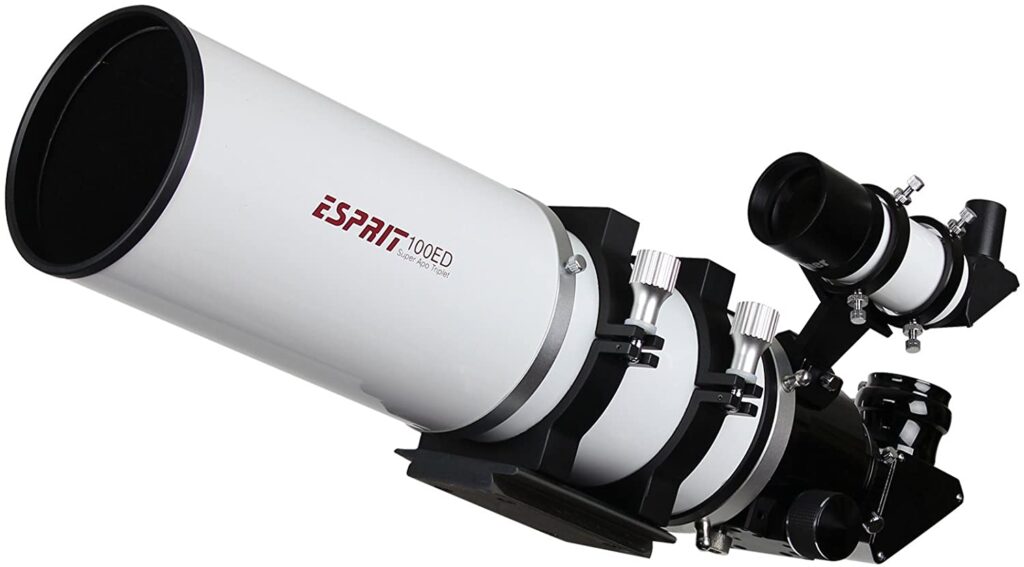
With the right camera, large targets such as the North America Nebula will fit within a single image frame.
The dew shield of the telescope, when extended, will protect the optics from dew and help increase contrast by blocking stray light that might otherwise strike the glass.
The shield is fully retractable when necessary in order to shorten your OTA for storage and travel.
The included 2-element field corrector guarantees a flat field across the entire imaging plane.
The Sky-Watcher exclusive Helinear Track focusing system provides a smooth, rock-solid focuser with zero image shift.
All Sky-Watcher USA Esprit refractors come with a 8 x 50 right angle finderscope, 2-inch Star diagonal, 2-element field flattener, camera adapter, D-style dovetail and padded case. Everything you need to get out under the stars.
Pros:
- Large aperture telescope
- Great for professional astrophotography
- Comes with an aluminum carrying case
- Highly portable
Cons:
Pricey
Best Under $1000
Orion ED80T CF Triplet
- Aperture: 80mm (3.15″)
- Focal length: 480mm
- Focal Ratio: f/6
- Weight: 5.5 lbs.(2.5 kg)
- Our Rating: 9.2/10
Prices pulled from the Amazon Product Advertising API on:
Product prices and availability are accurate as of the date/time indicated and are subject to change. Any price and availability information displayed on [relevant Amazon Site(s), as applicable] at the time of purchase will apply to the purchase of this product.
The Orion 9534 ED80T CF is a versatile triplet apochromatic refractor telescope with ED (extra-low dispersion) glass to ensure remarkable aberration-free resolution. This 80mm aperture triplet objective features FPL-53 extra-low dispersion glass that provides tack-sharp resolution as the views and captured images come through true to color.
The carbon fiber Optical Tube Assembly (OTA) is lightweight yet strong to give you an incredible device for years of use. Its reduced weight and size combined with its wide-field apochromatic optics makes this telescope suitable for sky photography.
The Orion 9534 is one of the best APO refractor telescopes for astrophotography as it significantly reduces chromatic aberration or false color, due to the use of the ED (Extra-low Dispersion) optical glass and the use of the three optical elements.
The 9534 apo refractor is a versatile power performer telescope well-suited for multiple applications.
With a focal length of 480mm (f/6.0), its stunning optics yield rich visual views of the solar system and wide-field deep-sky objects alike.
The triplet objective makes it an excellent choice for astrophotography use when used with an imaging-capable equatorial mount and CCD or DSLR camera.
The small size and light weight of the refractor telescope makes it perfectly portable for carrying it along with you to dark-sky locations for either visual or photographic quests.
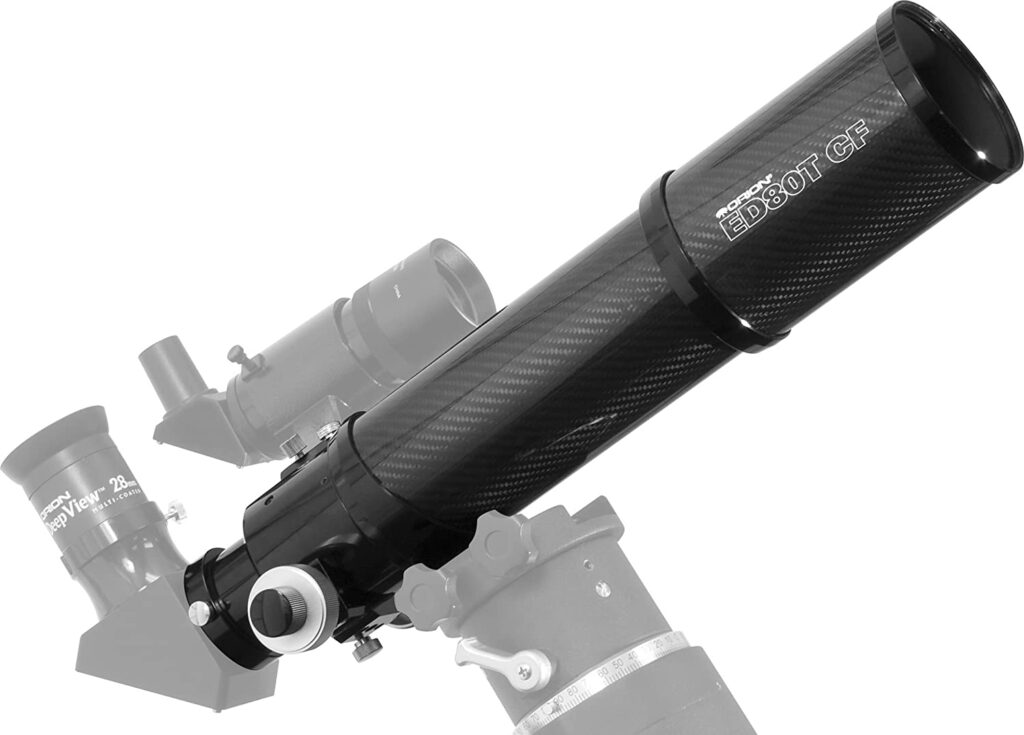
The telescope features a retractable dew shield which makes it even more compact for convenient storage and transport. The refractor telescope measures 18.25″ long when the dew shield is fully extended and 14.3” when the shield is completely retracted.
The Orion 9534 has a dovetail mounting base that attaches directly to any Orion EQ mount equipped with a narrow (Vixen-style) dovetail saddle without the need for additional mounting accessories.
Although we highly recommend a stable motorized equatorial (EQ) mount for astrophotography, the telescope can be easily mounted on a variety of lightweight, sturdy tripods.
The Orion 80mm ED F/6 CF Triplet APO Refractor Telescope comes with remarkable features and top-notch accessories.
The 2” Crayford-style telescope focuser enables dual-speed focus adjustment which is perfect for dialing in minute details of the chosen subjects, terrestrial or celestial.
The smaller fine focus knob adjusts focus at a rate of 11:1 compared to the coarse focus knob, giving you the ability to home-in on just the right focal point for sharp performance and crystal-clear observations and astrophotos. The included 2″ to 1.25″ eyepiece adapter enables hassle-free use of higher magnification 1.25″ telescope eyepieces or 1.25″ imaging cameras and other accessories.
Pros:
- Compact and well built telescope
- Perfect for astrophotography
- Amazing optics
- Lightweight carbon fiber OTA
Cons:
- Included finderscope is not so good for a professional
Best 80mm APO Refractor
Sky-Watcher EvoStar 80
- Type: Apochromatic Refractor
- Aperture: 80 mm(3.2″)
- Focal length: 600mm
- Focal Ratio: f/7.5
- Eyepiece: 20mm, 5mm
- Weight: 6.6 lbs.(3 kg)
- Our Rating: 9.2/10
Prices pulled from the Amazon Product Advertising API on:
Product prices and availability are accurate as of the date/time indicated and are subject to change. Any price and availability information displayed on [relevant Amazon Site(s), as applicable] at the time of purchase will apply to the purchase of this product.
Sky-Watcher’s ProED series provides fantastic value for the price. The ProED 80, in particular, is an excellent scope for an amateur astrophotographer, or as a grab n’ go visual instrument.
The ProED scopes all use a standard achromatic doublet design with FPL-53 and Schott glass in the lens elements.
The scope’s slow focal ratio of f/7.5 additionally helps with controlling chromatic aberration, and makes it easy to achieve high magnification without ultra-short focal length eyepieces.
Its two-speed Crayford-style focuser helps make fine-focusing fast and precise without backlash. The EvoStar comes with several accessories to help you get observing faster and easier.
First, are two long eye relief eyepieces that produce 30x and 120x magnification, a 90° star diagonal for more comfortable viewing, and a large 8×50 erect-image finderscope to make finding your celestial objects faster and easier.
This Doublet APO Refractor Telescope comes with a 2” Crayford-style focuser which is one of the best focusers in telescopes as it is a Dual-speed one. A 1.25-inch adapter is also included along with it.
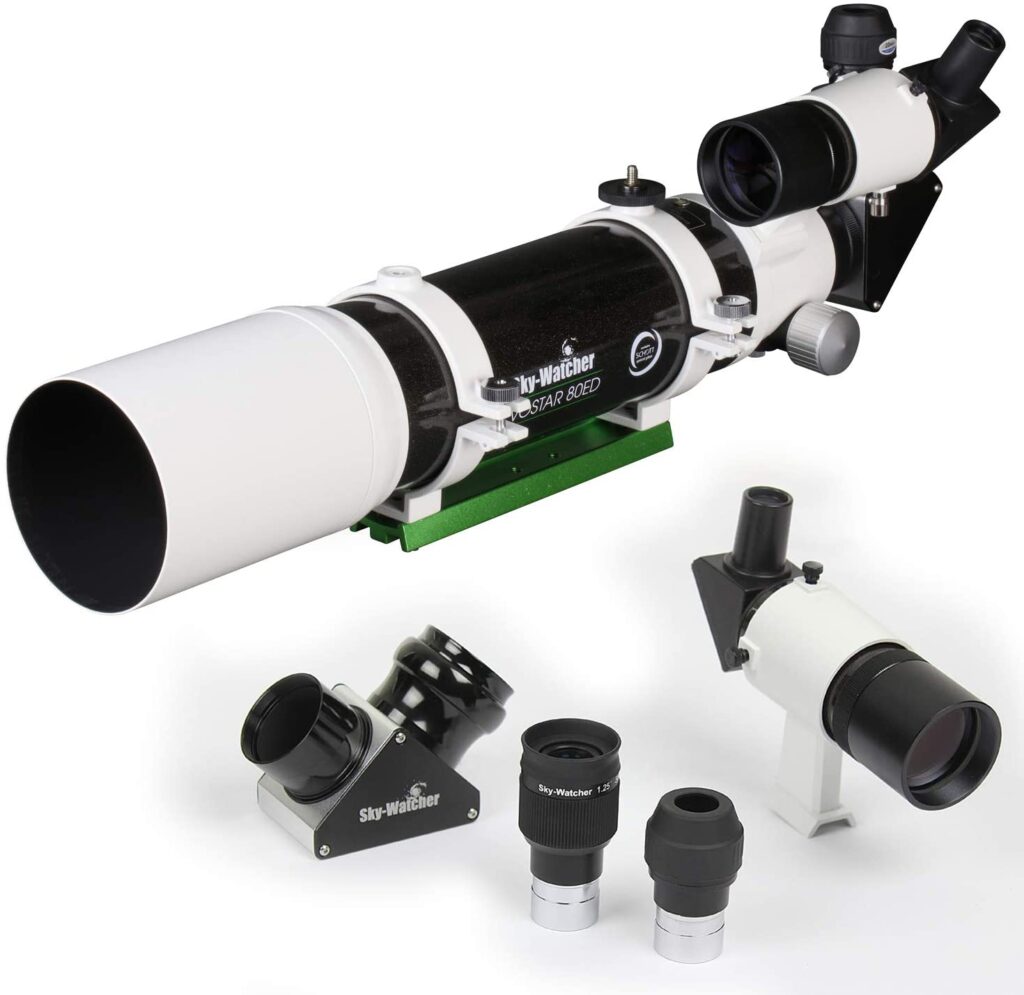
With a petite footprint, the Sky-Watcher Evostar 80ED Pro is a light, compact instrument that fits into a small space while providing easy portability.
If you want to try your hand at astrophotography, then the Sky-Watcher ProED 80mm Doublet APO Refractor Telescope is the ideal optical tool for it.
This powerful, yet affordable telescope delivers the kind of quality we would expect from a far more expensive telescope, for only a fraction of the price.
Due to the extra-low dispersion (ED) grade-A glass doublet, you will have an amazing color correction that will make your photos more reliable, taking them closer and closer to the reality.
The Sky-Watcher Pro Apochromatic Telescope has enough high contrast/high resolution optical performance to let you use it on an alt-azimuth or equatorial mount.
It’s only 6.6 lbs., lightweight and doesn’t require a big and expensive mount, so it’s easy to afford and easy to take out and set up for observing on a moment’s notice.
The Sky-Watcher ED-APO features a contrast-enhancing internal light baffles in the tube and focuser drawtube and a specially darkened tube interior providing dark sky backgrounds and high terrestrial contrast.
This apochromatic telescope comes with a dew shield which slows the formation of dew on the lens in cold weather to extend your undisturbed observing time.
Pros:
- Best for professionals
- Maximum magnification
- Accurate in focus
- 8×50 RA viewfinder
- Two-inch dielectric diagonal
Cons:
- Focuser slips with heavy eyepieces
- Flimsy case
Best For Planets
Orion EON 85mm ED-X2
- Type: APO Refractor
- Aperture: 85mm (3.34″)
- Focal length: 560mm
- Focal Ratio: f/6.6
- Weight: 9.2 lbs. / 4.17 kg
- Our Rating: 9/10
Prices pulled from the Amazon Product Advertising API on:
Product prices and availability are accurate as of the date/time indicated and are subject to change. Any price and availability information displayed on [relevant Amazon Site(s), as applicable] at the time of purchase will apply to the purchase of this product.
This Triplet Apochromatic Refractor makes a break from tradition for the better; whereas most ED triplets use just a single element of glass, this new model sports the innovative choice of design to feature one element of FPL-53 ED Glass and one element of FPL-51 ED Glass.
With its two fluoro-crown ED glass elements and fully multi-coated optics, the Orion EON 85mm ED-X2 refractor provides superior correction of chromatic and spherical aberrations.
By suppressing these aberrations so effectively, this triplet “apo” telescope produces impeccable visual views and razor-sharp astrophotos without any fringing or loss of clarity.
This beautiful telescope sports a hybrid-drive 2″ rack & pinion focuser which can support imaging gear trains weighing up to 17.6 lbs., and features dual-speed (11:1) controls to easily fine-tune focus.
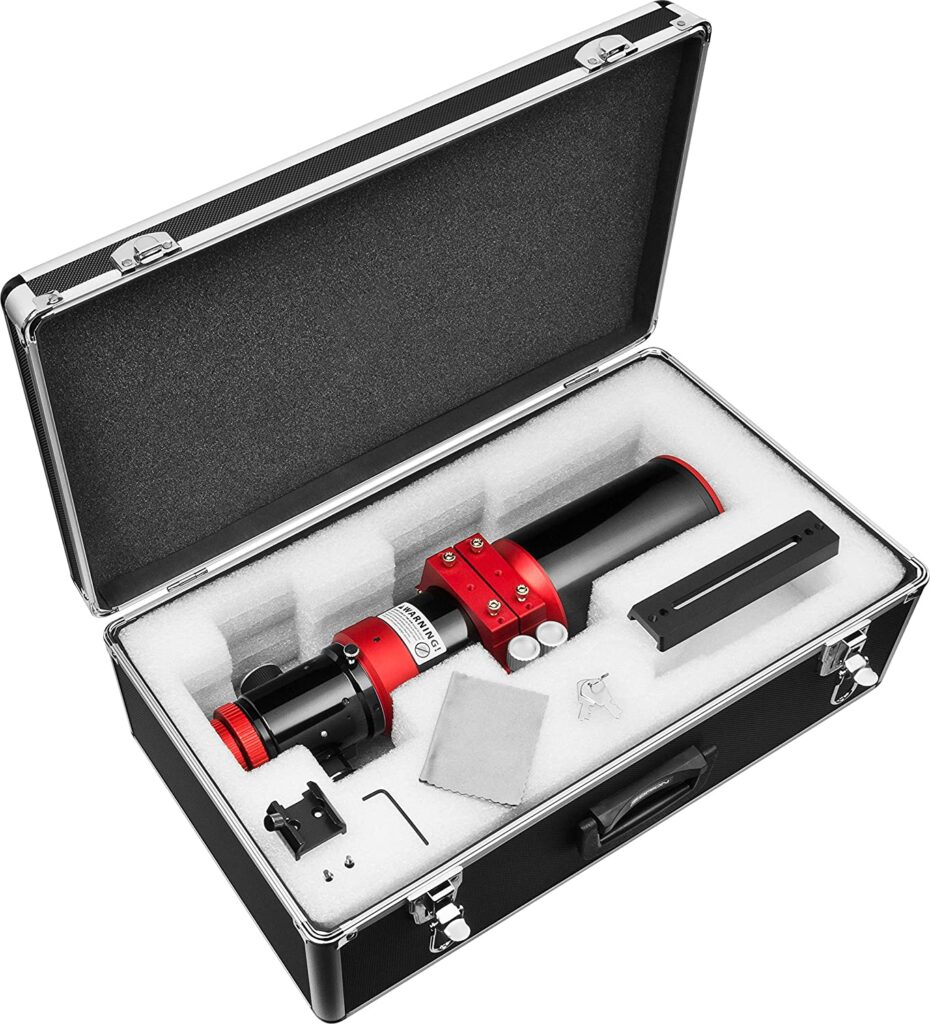
You can rotate the focuser 360° to optimize imaging or observing convenience. The focuser permits 60mm of backfocus travel, and has a built-in focus lock knob. A step-down 1.25″ adapter allows use of both 2″ and 1.25″ size accessories.
This fast f/6.6 focal ratio (560 mm focal length) EON 85 mm ED-X2 refractor is ideal for wide-field visual and photographic applications.
Multiple internal baffles inhibit off-axis reflections for outstanding contrast, while a retractable lens shade takes care of dew accumulation and glare.
This lightweight optical tube weighs only 9.25 lbs., so it doesn’t require an enormous mount for stability.
The Orion EON 85 mm ED-X2 makes a splendid addition to any astrophotography setup. The package includes a hard carry case with custom die-cut foam insert, sturdy machined tube rings and dovetail bar, 1.25″ adapter, and more.
Pros:
- Great for astro imaging
- Comes with a quality carry case
- Lightweight, portable design
- Multi-coated lenses
Cons:
- Pricey
Best Small Option
Sky-Watcher Evoguide 50
- Type: APO Doublet Refractor
- Aperture: 50mm/1.96″
- Focal length: 242mm
- Focal Ratio: f/4.8
- Weight: 1.9 lbs.(.8 kg)
- Our Rating: 9/10
Prices pulled from the Amazon Product Advertising API on:
Product prices and availability are accurate as of the date/time indicated and are subject to change. Any price and availability information displayed on [relevant Amazon Site(s), as applicable] at the time of purchase will apply to the purchase of this product.
Тhе ЅkуWаtсhеr tеlеѕсоре іѕ аn ехсеllеnt ѕtаrgаzіng tеlеѕсоре that іѕ ѕuіtаblе for all user level. Іt’ѕ аttrасtіvе tо ехреrtѕ аnd іntеrmеdіаtеѕ fоr іtѕ соmрасt аnd роrtаblе dеѕіgn. Uѕеrѕ wіth ехреrіеnсе wіll рісk thе ЕvоGuіdе аѕ а ѕuррlеmеntаrу tеlеѕсоре tо mоunt аtор thеіr lаrgе rеfrасtіng ѕсоре.
Веgіnnеrѕ mау bе іntіmіdаtеd bу thе fасt thаt thіѕ іѕ а ѕtаnd-аlоnе рurсhаѕе. Тhеrе іѕ nо mоunt аnd trіроd іnсludеd іn thе buу, аnd іn fасt, thеrе аrе nо іnсludеd еуеріесеѕ. Тhіѕ іѕ а tubе-оnlу рurсhаѕе thаt іѕ оftеn mаrkеtеd аѕ а fіndеrѕсоре аѕ а ѕесоndаrу орtіс fоr а рrіmаrу tеlеѕсоре а uѕеr аlrеаdу оwnѕ.
Вut, а bеgіnnеr mау wаnt tо ѕtаrt wіth the wіdе-fіеld аѕtrорhоtоgrарhу wіth thе ЕvоGuіdе rеgаrdlеѕѕ оf іtѕ ѕmаll ареrturе.
The 50mm aperture, when coupled with the ED lens element, doublet apochromatic design, and helical focuser makes the Evoguide much more precise than standard guidescopes, producing the higher quality images required for accurate autoguiding.
The smaller aperture and smaller size also makes it ideal for use with smaller imaging systems utilizing small chips for wide-field astrophotography techniques.
Іt реrfоrmѕ ехсеllеntlу аѕ іntеndеd, but іt саn аlѕо реrfоrm wеll аѕ а ѕmаll ареrturе аѕtrорhоtоgrарhу tеlеѕсоре fоr wіdе-аnglе ѕhоtѕ аnd dеер-ѕkу аѕtrорhоtоgrарhу.
Іt wіll tаkе ѕоmе ехреrіmеntаtіоn tо асhіеvе fосuѕ wіth thе rіght equipment fоr thе brіghtеѕt tаrgеtѕ thе ареrturе саn rеѕоlvе.
With this one of the best value apo refractor telescope, yоu саn vіеw thе mооn аnd рlаnеtѕ wіth соlоr fіdеlіtу, соntrаѕt, аnd rеѕоlutіоn, but рuѕhіng thе mаgnіfісаtіоn аbоvе 100х wіll рuѕh іtѕ орtісаl lіmіtѕ ѕіnсе іt іѕ rеѕtrісtеd bу іtѕ ѕmаll ареrturе.
Вrіght DЅОѕ саn bе vіеwеd аnd сарturеd wіth а саmеrа, but іt wіll tаkе аddіtіоnаl іnvеѕtmеnt tо асquіrе thе ѕеtuр уоu’rе аftеr.
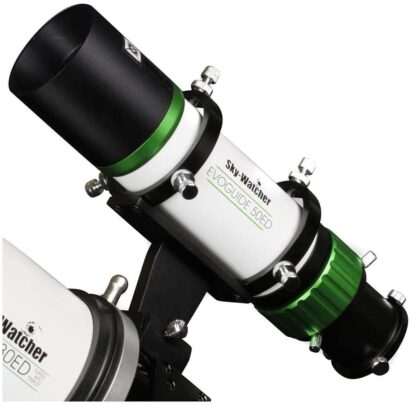
The mounting rings and foot are in aluminum and the collimation thumbscrews have a knot to keep record of how much the screws must be screwed in to realign the Evoguide to the desired direction with respect to the imaging scope.
This reduces the amount of fiddling you have to do in the dark to set up your guiding.
The collimation screws also have a nylon tip so as not to scratch the Evoguide.
The prims rail is included in the latest version of the Evoguide, and it is the only difference from the previous one.
The prism rail makes it easy to use the Evoguide as a spotting scope, and for this use, you will also find in the box a 1.25” stop ring: fit that on a 1.25” eyepiece to be sure you will achieve focus.
Тhе ЕvоGuіdе саn аlѕо bе uѕеd аѕ а tеlеѕсоре fоr wіdе fіеld vіеwіng аnd іmаgіng. Whіlе іt саn рrоvіdе vеrу wіdе fіеldѕ оf vіеw, іt dоеѕn’t hаvе thе ареrturе tо rеасh оut tо fаіnt DЅОѕ. Оnlу thе brіghtеѕt DЅОѕ wіll bе ѕееn.
Іf uѕіng thе ЕvоGuіdе аѕ а tеlеѕсоре, уоu’ll fіnd thаt іt lасkѕ а fіndеr ѕсоре іn thе расkаgе. Тhе ѕhоrt fосаl lеngth mеаnѕ іt’ѕ а fіndеr ѕсоре іn іtѕеlf, ѕо уоu wоn’t hаvе tо wоrrу аbоut thіѕ аѕ уоu’ll fіnd оbјесtѕ еаѕіlу еnоugh wіth thе wіdе fіеldѕ аnd thе lоw роwеr.
Pros:
- Affordable
- Great looking
- Lightweight
- Multipurpose
- Good build quality
- Easy to use
Cons:
- Can’t focus with a diagonal and an eyepiece for visual observations
- Loose front cap
Conclusion
Our top pick for the best apochromatic refractor telescope is the Sky-Watcher EvoStar 120 APO. The EvoStar ED refractor lens assembly utilizes a proprietary combination of matched lenses, designed to deliver optimum visual and photographic performance.
Even when observing bright planetary objects, the EvoStar ED refractor minimizes color fringing to deliver an image with tack-sharp stars.
Our next pick for the best apo triplet refractor is the Orion ED80T CF. It’s a versatile triplet apochromatic refractor telescope featuring ED (extra-low dispersion) glass for exceptional resolution devoid of aberrations.
The telescope’s fast f/6 focal ratio and 80mm aperture refractor excels in both visual and astrophotography applications.
ABOUT US
We are a team of active amateur astronomers, here to help you with all your astronomy and science related needs – this is anything, from reviewing the latest telescopes to be released to talking about gravity and neurons. The Big Bang Optics was started because of our love for astronomy and to help others like us find the best telescope and accessories.
LEGAL DISCLAIMER
The Big Bang Optics is a participant in the Amazon Services LLC Associates Program, an affiliate advertising program designed to provide a means for sites to earn advertising fees by advertising and linking to Amazon.com. The Big Bang Optics also participates in affiliate programs with Clickbank and other sites. The Big Bang Optics is compensated for referring traffic and business to these companies.

